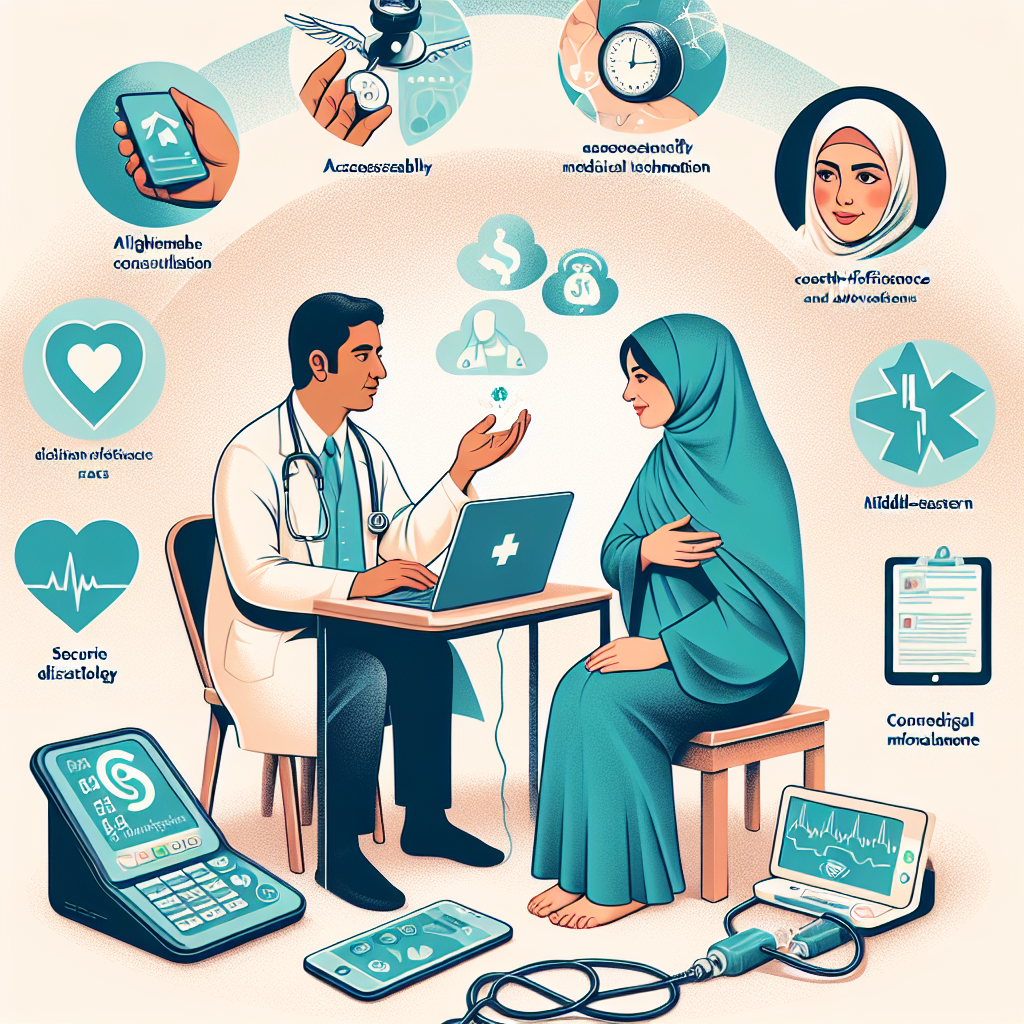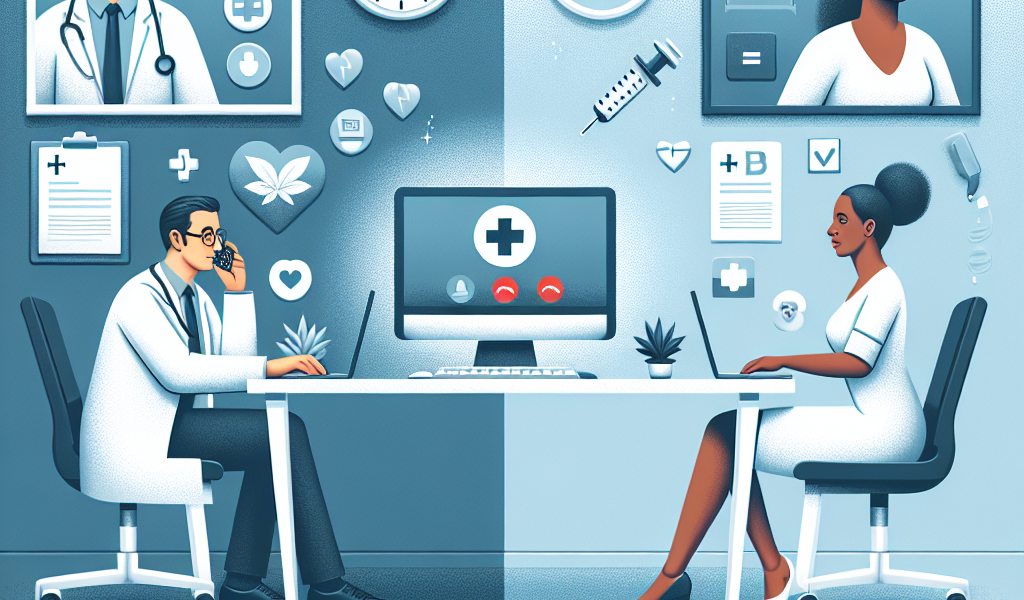-
Table of Contents
“Revolutionizing Care: Telemedicine for Accessible, Efficient, and Personalized Healthcare”
Introduction

Telemedicine, the practice of delivering healthcare services remotely through telecommunications technology, has revolutionized modern healthcare by enhancing accessibility, efficiency, and patient outcomes. This innovative approach allows patients to consult with healthcare providers from the comfort of their homes, reducing the need for travel and minimizing exposure to contagious diseases. Telemedicine also facilitates timely medical intervention, particularly in rural or underserved areas where access to healthcare facilities may be limited. By leveraging digital tools and platforms, telemedicine supports continuous monitoring and management of chronic conditions, improves coordination among healthcare professionals, and optimizes resource utilization. As a result, telemedicine not only enhances the quality of care but also contributes to cost savings for both patients and healthcare systems, making it an indispensable component of contemporary medical practice.
Improved Access to Healthcare Services
In recent years, telemedicine has emerged as a transformative force in the healthcare industry, offering a myriad of benefits that extend far beyond the convenience of virtual consultations. One of the most significant advantages of telemedicine is its ability to improve access to healthcare services, particularly for individuals in remote or underserved areas. This technological advancement has the potential to bridge the gap between patients and healthcare providers, ensuring that quality medical care is within reach for everyone, regardless of their geographical location.
For many people living in rural or isolated communities, accessing healthcare services can be a daunting challenge. The nearest medical facility may be hours away, and the journey itself can be fraught with difficulties, especially for those with limited mobility or chronic health conditions. Telemedicine addresses this issue by allowing patients to connect with healthcare professionals from the comfort of their own homes. Through video calls, phone consultations, and online messaging, patients can receive timely medical advice, diagnoses, and even prescriptions without the need for lengthy travel. This not only saves time and reduces stress but also ensures that individuals receive the care they need when they need it.
Moreover, telemedicine plays a crucial role in reducing the strain on healthcare systems, particularly in times of crisis. During the COVID-19 pandemic, for instance, telemedicine became an essential tool for managing patient care while minimizing the risk of virus transmission. By enabling remote consultations, healthcare providers could continue to offer essential services while protecting both patients and medical staff from potential exposure. This adaptability highlights the resilience of telemedicine in the face of unprecedented challenges and underscores its importance in maintaining continuity of care.
In addition to improving access for rural populations, telemedicine also offers significant benefits for urban residents. In bustling cities, where healthcare facilities are often overwhelmed by high patient volumes, telemedicine can alleviate some of the pressure on hospitals and clinics. Patients with non-emergency conditions can opt for virtual consultations, freeing up resources for those who require in-person care. This not only enhances the efficiency of healthcare delivery but also reduces waiting times and improves patient satisfaction.
Furthermore, telemedicine has the potential to address disparities in healthcare access among different socioeconomic groups. For individuals who may struggle with transportation costs or time off work, virtual consultations provide a more accessible and affordable option. By eliminating the need for travel and reducing associated expenses, telemedicine makes healthcare more equitable and inclusive. This is particularly important for marginalized communities, who often face significant barriers to accessing quality medical care.
Another noteworthy aspect of telemedicine is its ability to facilitate continuity of care for patients with chronic conditions. Regular monitoring and follow-up appointments are essential for managing chronic illnesses, but frequent visits to healthcare facilities can be burdensome for patients. Telemedicine offers a practical solution by enabling ongoing communication between patients and their healthcare providers. Through remote monitoring tools and virtual check-ins, patients can receive consistent care and support, helping them to better manage their conditions and improve their overall quality of life.
In conclusion, the benefits of telemedicine in improving access to healthcare services are undeniable. By breaking down geographical barriers, reducing strain on healthcare systems, and promoting equity in healthcare access, telemedicine is revolutionizing the way medical care is delivered. As technology continues to advance, the potential for telemedicine to enhance healthcare access and outcomes will only grow, making it an indispensable component of modern healthcare.
Cost-Effective Medical Consultations
In recent years, telemedicine has emerged as a transformative force in the healthcare industry, offering a range of benefits that extend beyond mere convenience. One of the most compelling advantages of telemedicine is its potential to provide cost-effective medical consultations, a factor that is increasingly important in today’s economic climate. As healthcare costs continue to rise, both patients and providers are seeking innovative solutions to make medical care more affordable without compromising quality. Telemedicine, with its ability to connect patients and healthcare professionals through digital platforms, stands out as a promising answer to this pressing issue.
To begin with, telemedicine significantly reduces the need for physical infrastructure, which is a major cost driver in traditional healthcare settings. Hospitals and clinics require substantial investments in real estate, utilities, and maintenance. By contrast, telemedicine leverages existing technology, such as smartphones and computers, to facilitate consultations. This shift not only lowers overhead costs for healthcare providers but also translates into savings for patients, who no longer need to travel to a physical location for routine check-ups or follow-up appointments.
Moreover, telemedicine minimizes the indirect costs associated with seeking medical care. For many patients, especially those living in rural or underserved areas, accessing healthcare can involve long commutes, time off work, and additional expenses such as childcare or transportation. Telemedicine eliminates these barriers by allowing patients to consult with healthcare professionals from the comfort of their own homes. This convenience is particularly beneficial for individuals with chronic conditions who require regular monitoring, as it reduces the frequency of in-person visits and associated costs.
In addition to lowering direct and indirect costs, telemedicine also enhances the efficiency of healthcare delivery. Traditional in-person consultations often involve lengthy wait times, both in scheduling appointments and in waiting rooms. Telemedicine platforms streamline this process by offering more flexible scheduling options and reducing the time spent waiting for a consultation. This increased efficiency not only improves patient satisfaction but also allows healthcare providers to see more patients in a given timeframe, thereby optimizing resource utilization.
Furthermore, telemedicine has the potential to reduce the overall burden on the healthcare system. By providing an alternative to emergency room visits for non-urgent issues, telemedicine can help alleviate overcrowding in hospitals and clinics. This is particularly relevant in the context of public health crises, such as the COVID-19 pandemic, where minimizing physical contact is crucial. By diverting non-critical cases to virtual consultations, telemedicine helps ensure that healthcare resources are allocated to those who need them most, ultimately contributing to better health outcomes and cost savings.
Another important aspect to consider is the role of telemedicine in preventive care. Early detection and timely intervention are key to managing many health conditions effectively. Telemedicine facilitates regular monitoring and follow-up, enabling healthcare providers to identify potential issues before they escalate into more serious and costly problems. This proactive approach not only improves patient health but also reduces the long-term costs associated with treating advanced stages of diseases.
In conclusion, telemedicine offers a multifaceted solution to the challenge of rising healthcare costs. By reducing the need for physical infrastructure, minimizing indirect expenses, enhancing efficiency, alleviating system burdens, and promoting preventive care, telemedicine provides a cost-effective alternative to traditional medical consultations. As technology continues to advance and become more accessible, the adoption of telemedicine is likely to grow, bringing its benefits to an even wider audience. In this evolving landscape, telemedicine stands as a testament to the potential of innovation to make healthcare more affordable and accessible for all.
Enhanced Patient Monitoring and Follow-Up
Telemedicine has revolutionized the landscape of modern healthcare, offering a myriad of benefits that extend far beyond the convenience of virtual consultations. One of the most significant advantages lies in enhanced patient monitoring and follow-up, which has the potential to transform patient outcomes and overall healthcare efficiency. This shift towards digital health solutions is not just a technological advancement but a compassionate response to the evolving needs of patients and healthcare providers alike.
In the traditional healthcare model, patient monitoring and follow-up often involve multiple in-person visits, which can be both time-consuming and stressful for patients. For those with chronic conditions, frequent trips to the doctor can become a significant burden, leading to missed appointments and suboptimal care. Telemedicine addresses this issue by enabling continuous monitoring through remote devices and virtual check-ins, ensuring that patients receive timely and consistent care without the need for constant travel.
Moreover, telemedicine facilitates real-time data collection, allowing healthcare providers to track vital signs, medication adherence, and other critical health metrics from a distance. This continuous flow of information enables doctors to detect potential issues early, adjust treatment plans promptly, and provide personalized care tailored to each patient’s unique needs. For instance, a patient with diabetes can use a connected glucose monitor to send daily readings to their healthcare team, who can then make immediate adjustments to their insulin regimen if necessary. This proactive approach not only improves health outcomes but also enhances the patient’s quality of life by reducing the risk of complications.
Another compelling benefit of telemedicine in patient monitoring and follow-up is its ability to bridge the gap between healthcare providers and patients in remote or underserved areas. Rural communities often face significant barriers to accessing quality healthcare, including long travel distances and a shortage of medical professionals. Telemedicine breaks down these barriers by bringing expert care directly to the patient’s home, ensuring that even those in the most isolated locations can receive the attention they need. This democratization of healthcare is a testament to the power of technology to create a more equitable system.
Furthermore, telemedicine fosters a more collaborative approach to healthcare by facilitating seamless communication between different members of a patient’s care team. Specialists, primary care physicians, and other healthcare providers can easily share information and coordinate care plans through secure digital platforms. This integrated approach ensures that all aspects of a patient’s health are considered, leading to more comprehensive and effective treatment strategies. For patients, this means fewer gaps in care and a more cohesive healthcare experience.
The psychological benefits of telemedicine should not be overlooked either. For many patients, especially those with chronic illnesses or mobility issues, the ability to receive care from the comfort of their own home can significantly reduce anxiety and stress. The familiar environment of home can make patients feel more at ease during consultations, leading to more open and honest communication with their healthcare providers. This enhanced rapport can result in better adherence to treatment plans and a stronger patient-provider relationship.
In conclusion, the benefits of telemedicine in enhanced patient monitoring and follow-up are profound and far-reaching. By offering continuous, real-time monitoring, improving access to care, fostering collaboration among healthcare providers, and reducing patient stress, telemedicine is not just a technological innovation but a compassionate evolution in the way we approach healthcare. As we continue to embrace these digital solutions, the potential for improved patient outcomes and a more efficient healthcare system becomes increasingly evident.
Conclusion
In conclusion, telemedicine offers numerous benefits in modern healthcare, including increased accessibility to medical services, especially for individuals in remote or underserved areas. It enhances convenience and efficiency by reducing the need for travel and wait times, and it allows for more timely medical consultations and follow-ups. Telemedicine also supports better management of chronic diseases through regular monitoring and virtual check-ins, and it can lead to cost savings for both patients and healthcare providers. Additionally, it facilitates greater collaboration among healthcare professionals and can improve patient outcomes through more personalized and continuous care. Overall, telemedicine represents a significant advancement in healthcare delivery, promoting a more inclusive, efficient, and effective healthcare system.





